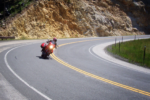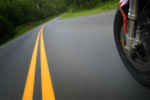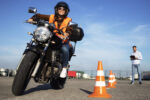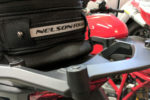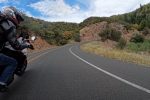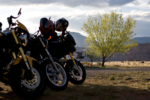Before actually getting into the tips and tricks for overcoming slower moving vehicles, its important to state that passing other vehicles on twisty, two-lane tarmac is one of the most dangerous aspects of fast-paced motorcycling. As stated by Nick Ientash in The Pace “your lane is your limit”, as soon as you cross over that yellow line, dotted or otherwise, there is not a single law or regulation that will back you up. Nor will any law enforcement officer be in your corner should anything go wrong. And if at any time you are caught on the left side of a double yellow line you just may end up with a trip to the hospital or a reckless driving ticket. In other words, take passing very seriously!
Additionally, in this litigation-happy society of ours, I must also mention that the following information is for recreational purposes only. It cannot guarantee safety or success. Full responsibility for one’s actions falls to the individual. More »
The Principle
It seems that over the course of the past few years, the dashed yellow lines that used to dot our highway system have slowly been replaced by double yellow lines; even down long straight sections where oncoming traffic can be seen for more than a mile. I’ve come to the conclusion, with no scientific evidence or research, that passing zones are created with the lowest common denominator in mind. Dotted lines are only placed where a ’78 Pinto pulling a 20ft trailer could safely pass a tractor-trailer.
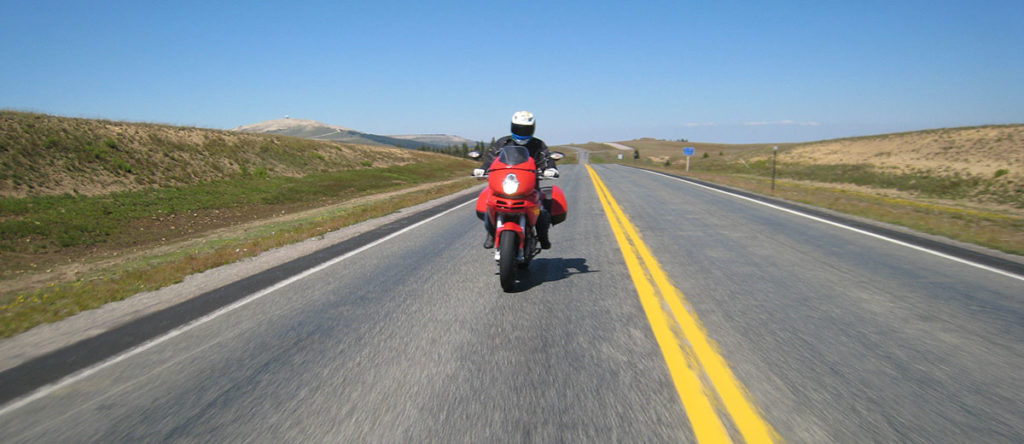
I have therefore concluded that since white signs, such as speed limits etc. represent the law and since yellow signs, such as slippery when wet, represent advisories, the same rule should be applied to the paint on the road. The yellow lines are advisory. This is by no means legal or accurate, but it helps me justify my actions to myself.
Most motorcyclists, particularly ones who would read this, learn quickly that going fast in a straight line requires very little skill while cornering efficiently is infinitely more difficult and equally more rewarding. As ones riding ability increases the desire for forward velocity on twisty roads increases. However, the average automobile driver is more concerned with the cabin temperature and the program on the radio (or television, phone, ipad, etc.) than the actual act of driving and will likely travel at a much slower speed on twisty roads. Other problem vehicles are those whose size limits speed, particularly on steep grades.
The Risks
Passing is a combination of calculated risks. All the factors need to be added together to determine how risky the pass is. As with everything, everybody is going to determine the risk a little differently and be willing to accept different levels of risk. Never be pressured into a pass. Make your own decisions. Just because the rider in front of you thought it was safe to pass doesn’t mean it is safe for you.
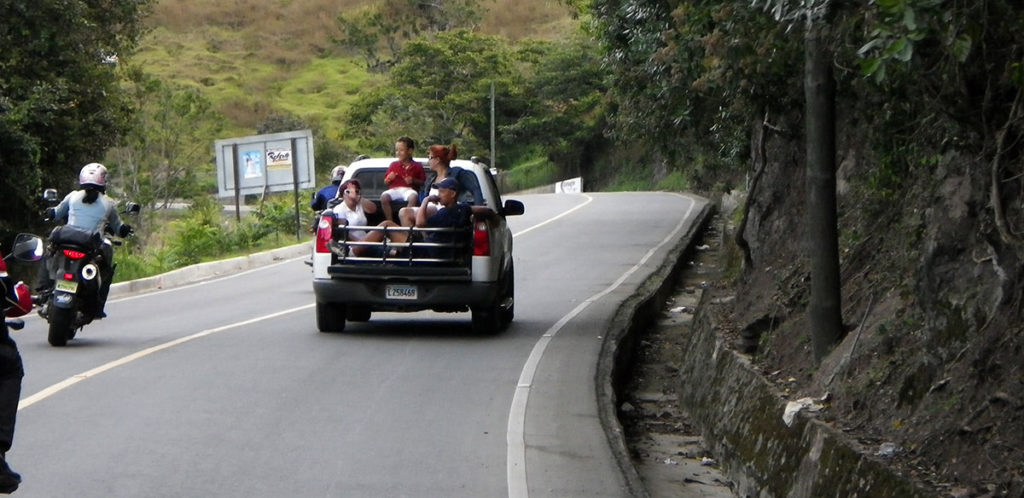
Several additional risks are associated with the slow moving vehicle. A distracted or unskilled driver will tend to drift and wander in and out of their lane. They also tend to apply the brakes mid corner. No biggie in a car, but extremely dangerous for a two-wheeled vehicle where traction is a premium. The risk of vehicular conflict from the rear is greater and a train of vehicles trapped behind a particularly slow moving vehicle could result in aggressive passes by overzealous drivers thereby creating a dangerous environment.
The goal of passing is two-fold; decrease the chance of vehicular conflict as well as maintain the quality of riding experience. A good motorcyclist will learn how to read traffic, the road, and the situation; they’ll learn to make wise decisions. The overall objective is to stay safe and sometimes the safest thing to do is nothing.
Patience
When in doubt, don’t! Never be in a hurry or impatient. It is critical to be willing to wait until a safe place to pass is found. Familiarity with the road or a good map/GPS can be beneficial. Why risk an aggressive pass when the road opens up to a passing lane soon or a small town is just around the corner?
Furthermore, before chancing a pass, assume there is a car just beyond your sight. Ask myself before you go, If a car were to pop out right now would I still be able to make the pass safely? If the answer is no, then do not pass. Regardless. It can be frustrating when you turn down several passes when no oncoming traffic is revealed, but that’s where the patience comes in. It’s simply not worth the risk.
Hesitation
Hesitation is an enemy and it is important to be quick and decisive. A little bit of aggression is okay, as long as it does not override reason. Know your motorcycle and what it is capable of. It’s a good idea to prepare for the pass early. Downshift so you have more power. Turn on your signal to let everyone behind you, and maybe even the vehicles ahead, know that you plan to pass. As soon as you see that you have enough space, check your mirror and GO!
Now is not the time for a gradual roll-on, now is when you get to flex the awesome power to weight ratio of your motorcycle and enjoy that flatten-your-eyeballs-acceleration sensation. Get past the vehicle, and this is really important, check your mirror again. Is your buddy passing? Is the car behind you passing too? Know what’s behind you at all times!! Also, check your blind spot to be double-sure before moving back into your lane. It’s a good idea to stay on the throttle until you are safely back in your lane. It’s also wise to wait until you can see both of the overtaken vehicles headlights in your mirror before returning to your lane.
One of the greatest tools for passing another vehicle is knowing exactly when to attack. I’ve ridden behind motorcyclists who wait until the road is straight before making the pass, which uses up a lot of valuable space. Automobiles will probably continue to coast through to the end of the corner and only accelerate when the road straightens. Use that information. Start you acceleration as soon as you can see it’s clear and safe, hopefully while you are still in the corner – left corners particularly. Use the maneuverability and power of you bike and zip past while the auto is still coasting through the bend. You’ll be amazed how much less space you’ll need to pass when this technique is used. This is very rewarding because at least one corner can be salvaged. Besides, few things feel as good as knowing that rear tire is biting the asphalt as you accelerate out of a corner. Just be sure it is clear. Having to do a reactionary brake jam when an unexpected car pops over the horizon is extra dangerous because you are using a lot of traction for cornering.
It’s very very important when you make your decision to pass to make sure that you not only have enough time and space to pass but also enough time and space to get back into your lane and down to a safe speed for the next corner. Motorcycles have fantastic brakes and can scrub off speed better than most vehicles on the road, but it’s critical that you are familiar with high-speed braking on your motorcycle. And don’t pass so aggressively that the auto you just passed has to stomp their brakes to avoid hitting you. Poor form.
Courtesy
You do not want to make an enemy of the driver you are passing despite how frustrating or dangerous they can be. You want to slip in and out of their conscious world before the next corner. Upset them and all they have to do is dial 911 on their mobile and you get to have a nice chat with a local constabulary. I’ve also heard of a few stories where the small town cop, hungry for action, saw fit to block the road with his car and draw the unused pistol on the unsuspecting, aggressive passing motorcyclist who angered a cellphone armed auto-driver. That’s not the kind of welcome I ever want to get.
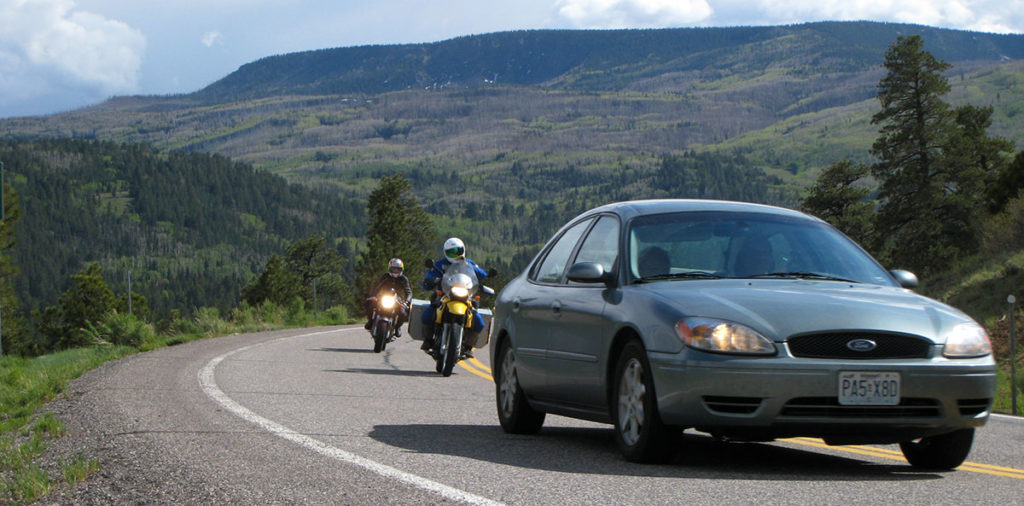
Many auto drivers may take personal offense to your passing them, particularly on the double yellow line. Not only are you in clear violation of the law, but you may also be in violation of some sort of fairness issue the driver may have. Imagine what the driver may say when you pass. “Hey, that’s not fair! [I’m still stuck behind this guy] He can’t pass on a double yellow like that! I’m going the speed limit and nobody should be going faster than me What an ass! I sure wish I could do that.”
I’ve been flipped off, screamed at, cursed at, had trash thrown at me and horns blared when passing. If this happens its bad news. You’ve obviously upset them enough that you are risking a case of road rage or a phone call. Stay calm and continue merrily on your way unfettered. Don’t take any of it personally, if you do, they win. How would you feel if you were driving a 1991 Chrysler Caravan with the wooden contact paper peeling off the doors while being forced to watch a bunch of really cool motorcycles having a great time? I’d be cranky too.
Not upsetting the driver can be done a couple of ways. If you have the room, you can simply not blast past the driver, but gently accelerate past them. It also helps to move as far to the left as safely possible; that way the driver does not feel like you are buzzing them, or fear that you may clip their mirror or front bumper. Moving left is extra important when you have to pass at a high rate of speed because your genuine speed is masked by distance. Many drivers really have no concept of the definite size of their vehicle and may feel like you are a lot closer than you actually are. Give them lots of space. Remember you want to be forgotten.
On more than one occasion, a vehicle that I had passed, stopped at the same eatery we happened to stop at and I was given the opportunity to chat with the driver and get their perspective on the whole thing. More than once, I’ve been taken completely by surprise to learn that the driver is utterly terrified of motorcycles. They can not conceive that it is possible that motorcycles stay upright, particularly when they bank through a tight corner. They honestly fear they are about to witness a horrific crash, right in front of their eyes. I think this is as good a reason as any to be as thoughtful as possible when passing. The last thing you want is a panicked driver
Courtesy overflows to the vehicle behind you. Few things can be more frustrating to another rider than getting trapped behind a slow moving driver because of a thoughtless or last-second pass, and be forced to go slow while the other rider enjoys traffic-free bliss.
Stay on the throttle for the entire pass. Rolling off the throttle when you crest the front fender of the driver will result with the following rider rushing into your tailpipe hard and being forced to brake while hanging out in oncoming traffic. This can be extremely unnerving for the second rider and, in extreme cases, can result in them having to back all the way off and return to their spot behind the slow moving vehicle again. Instead, stay on the throttle until you are back in your lane, you certainly don’t want the rider following to ram into the back of you.
Something else you can do, instead of taking up your post in the left side of your lane near the yellow line, move as far to the right as possible. This gives the following rider a larger space cushion to get in front of the slow vehicle and safely brake before the next corner (if applicable) without having to squeak around you. If space permits, it can be very advantageous to the following rider(s) if you continue at the higher speed to create as large of a space as you can for the following rider(s) to move into.
Read the Situation
Keeping the eyes and mind sharp can reveal a lot of information. A glint off the glass, a shadow passing between trees, a mailbox, skid marks before the corner or even a worn road surface or road paint can all be valuable clues to how sharp or what may be around the next corner. Don’t trust the advisory speed signs. The road will tell you much more than a state-placed sign.
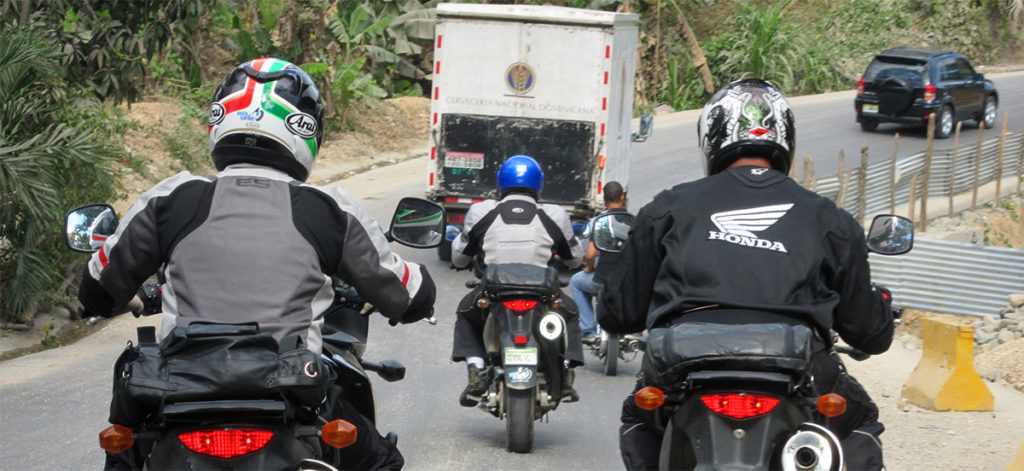
Passing requires more than just getting around the car and providing for enough room to slow down for the next corner. An escape route or back-up plan needs to be established before each and every pass. What if a car appears? What if that car is a cop? What if the car you are trying to pass tries to block you? What if you are attempting to pass a line of vehicles and a car in front of you tries to pass as well? All this, and more depending on the situation, needs to be dealt with and the best way to do it, is by paying attention to detail.
Watch what the driver and the passengers are doing. Are kids bouncing in the back seat? Is the passenger lying on the drivers lap? Is the driver on the phone? Odds are the drivers mind is elsewhere. Look at the condition of the car. Are the mirrors falling off and the windshield cracked? Is the dashboard piled with garbage and papers? Is there a duct-taped, plastic window where glass once was? Those are tale-tell signs that the driver doesn’t make the condition of their vehicle (and probably their driving) a priority. Also, be willing to start looking for trends in vehicles. For some reason, Ford F-350 drivers tend to be more aggressive and Subaru drivers tend to be more cautious. Not always, but patterns can be distinguished to help you make your decisions.
Oncoming Traffic
This is what you go to great lengths to avoid. Seeing a vehicle coming the other direction sucks. Particularly when you haven’t seen an oncoming car for five miles of great corners, but the first straight-away you come to is congested with a steady stream of cars, spaced just so there is no way to pass. Arrgh!
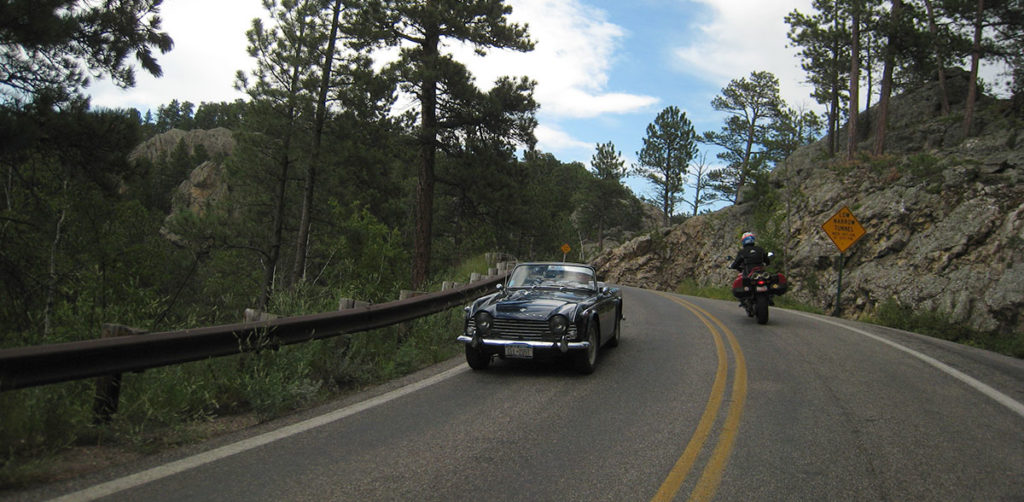
On the other side of the coin, the oncoming car is no longer a variable. It’s a known factor that can more easily be addressed. A lumbering RV is likely going pretty slow, giving you more time, while two, close to the ground, round headlights may mean Porsche.
Special Situations
Long Vehicles
Semi trucks with trailers or holiday seekers who cannot leave behind a single possession and choose to travel in a 40ft. Winnebago lugging a trailer with second car or a boat behind are a pain to get around. But their size can be your advantage. The larger the vehicle, the slower they tend to go. The key is to not hang on the rear bumper. When you do, you have lost all ability to see. Hang back a few car lengths to give yourself a greater visual lead. Besides, vehicles that large are easy to out-accelerate and get around anyway. There should be no reason to crowd the behemoth. The hard part is the visibility challenge they present.
Multiple Vehicles
Passing multiple vehicles simultaneously has many additional challenges and can be a lot like one or two long vehicles. When there are multiple vehicles it’s likely caused by one particularly slow one, which results in everybody else, impatiently ignoring the two-second following rule and plodding along less than one car length behind the vehicle in front of them. [Unless you are the lead elephant, the view never changes.]This leaves no room to pick off one car at a time and you are now required to find space and time to pass the entire convoy at once. When this happens, hold off and wait for things to change. It sucks, this is where problems and vehicular conflicts can arise.
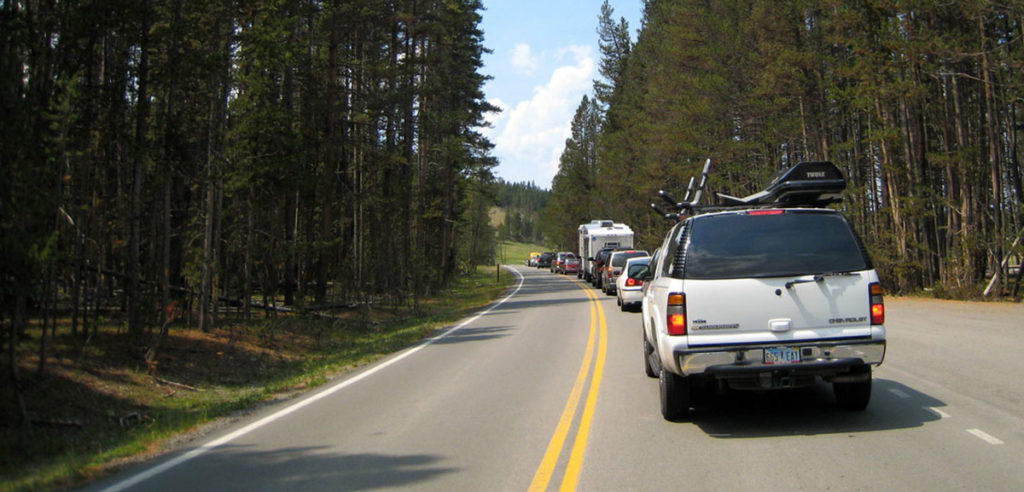
If one car starts to drift back, you may be able to slide into the spot. One time on the Pacific Coast Highway, we came up behind a similar convoy piled up behind one slow moving RV with a giant “Rent Me” sticker in the back window. Over the course of several miles, the number of cars began to stack deeper and deeper until the train was nearing a mile long. Had the lead RV not ignorantly passed several huge turnouts I would not have been so bothered. Unfortunately, in this case, there is very little aside that a small motorcycle can do.
Motorcycles
Despite them playing for the same team (we hope) motorcyclists are the least trustworthy of all those that we share the road with. Why? Because, other motorcyclists are the least predictable. Which makes it easier to understand many auto drivers frustration with us. It is almost impossible to gauge the rider’s skill level. The only generalization I’ve been able to make is that typically, the less protective gear, the lower the skill level. Again, this is not always the case. Newbies can leather up like a MotoGP racer and I’ve seen extremely polished riding following a dude in shorts, sandals, wife-beater and sunglasses – but those seem to be more of an exception than the norm.
The risks with getting around other motorcyclists compound because of the unknowns. Sometimes the rider will move to their right to allow you to slip by them, sharing the lane with them for a second. This is very gracious and appreciated, but rare. Sometimes, unfortunately, the rider will be indignant and try to prevent you from getting around them. I was, not so eloquently informed by one such rider, that it was just “damn stupid” to be going any faster than he was, because he’d been riding for twenty years longer than I’d been alive and he was taking it upon himself to slow me down. Thanks, but no thanks.
But even worse than that, is the reality that you could scare the living life out of a newer/inexperienced rider who is desperately trying to simply ride. Years ago, on my way to the annual H-D pilgrimage to Sturgis, I passed one such rider that nearly jumped off his bike because he was certainly not expecting anybody to pass him through a sweeping, double-yellow corner. The result was him veering to the left and almost colliding with me.
Because of the many bad experiences passing motorcycles, I now pass all other bikes with more caution than anything else on the road. Give other riders more space than you would your near-blind grandma who’s driving her ‘78 Buick to the corner market for Metamucil.
A Pack of Motorcycles
Woe to the rider who comes up behind a slow-moving pack of motorcycles worming their way through a canyon. If there is not already a massive pack of agitated auto drivers stacked behind them, they have already become the most difficult and dangerous type of pass imaginable! As soon as the number of bikes reaches into the double digits they can stretch out to the length of a football field, and because packs tend to ride in a stagger formation, far enough apart to be safe, but too close to squeezing into the middle, you are forced to attempt to pass the whole lot of them at once. Either that or try to find natural breaks to wedge yourself into. But be warned, when wedging in you could be met with scowls, scorn and protective riders who may try to block you out, forbidding you from escaping the oncoming lane. Many groups who ride in packs take “lane discipline” very seriously.
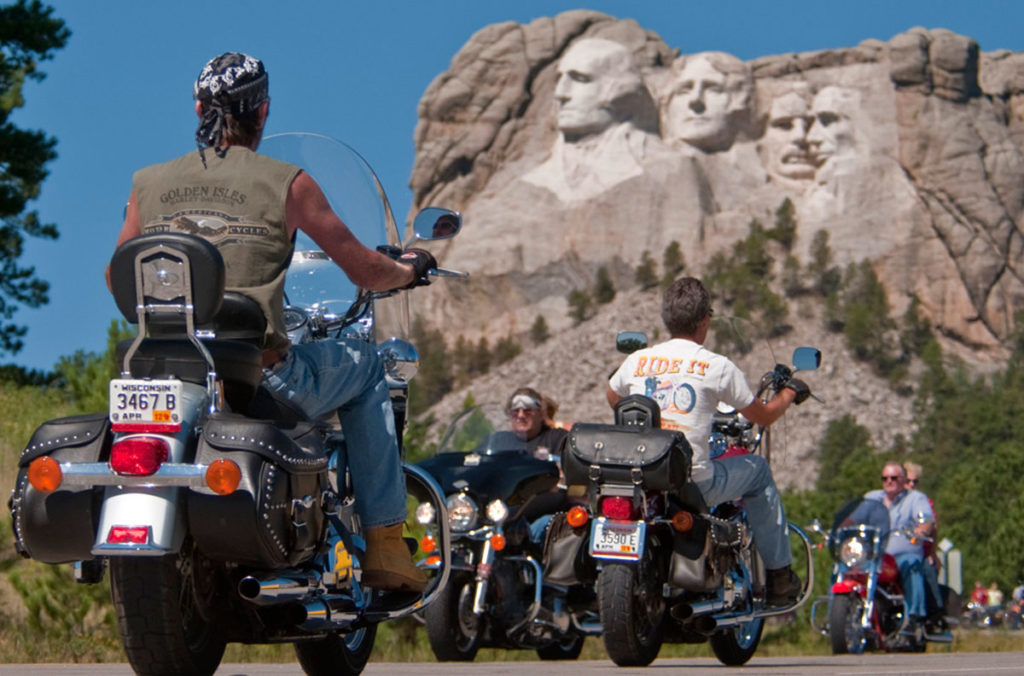
I have very little patience for this but aggravation doesn’t change the situation. Handle large packs of motorcycles with extreme caution. The pack will likely speed up annoyingly, in straight sections, only to slow way down again in the corners making it nearly impossible to overtake them. Do not, regardless of temptation, pass anyone on the right! The danger is immense and the varying levels of skill is a complete variable. Instead, try to develop a strategy. It can be done, but you will have to use every tool available to slowly pick them off whenever the situation presents itself. And situations will present themselves. One bike lags behind, jump in front of them. The group splits in half, jump into the middle. You are granted a long-empty straight-away, whisper a prayer of thanks and go for it.
Again, be ultra-cautious. Now is when you should try to be the nicest rider you know how to be. “Beep-beep” and wave a thanks to any who let you by. Give thumbs up and nods of approval of their bike if you have to cut in. Telling someone you appreciate their bike will almost certainly disarm and mellow them out. Again, you have no idea who these riders are or what their skill level.
Take outlaw colors, if you see them, very seriously. They are not a joke and some outlaw etiquette requires them to seek vigilante revenge on any motorcyclist who takes up point in front of their leader. I met a guy who claimed to have been followed for over fifty miles, at triple-digit speeds by three outlaws whom he’d passed, until he was finally able to outrun them. Spooky!
But for the most part, just treat other motorcyclists with an added level of respect. Realize there will probably be more than one brand-new rider following, or being followed, by a protective spouse running interference to compensate for the newbie’s lack of skill. The other thing is they could be tourists from another country who are slightly lost or bewildered. Don’t be the ugly American (like I shamefully was) and impatiently pass two wandering Harley’s trying to find a way into the pullout to photo the Grand Tetons capped in snow and caped with clouds. They were from Ireland and to their credit forgiving of my youthful stupidity. Be willing to wait for a safe place to get around your fellow motorcycle enthusiast.
Alternatives
Riding the Gap
When road conditions become so crowded that it is nearly impossible to pass all the slow-moving automobiles in your path, take advantage of the space you have been given. Find an open straight section with good visibility and instead of pinning the throttle and volleying for the front, come to a stop or near stop and wait. Wait until the next car comes up from behind. If you are fortunate, you may have to wait for two or three minutes for the next car to show up, at which point you get to take off and ride again. This will allow you to enjoy the clear traffic between the packs of cars.
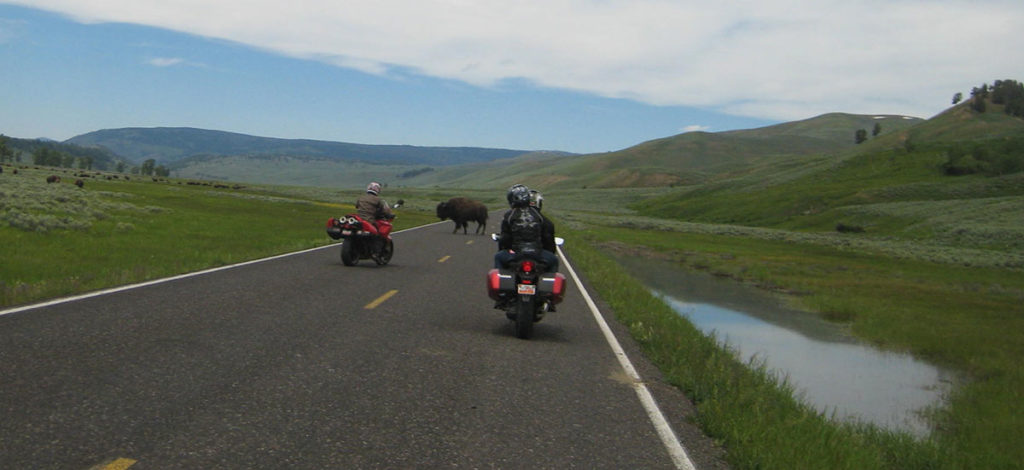
It helps to go slow down the straight-aways where other cars go fast and cops will expect speeding to prolong the clear space between traffic. Then you can pick the pace up again when the road gets twisty.
A variant, is to actually pull off the road and wait a few minutes until traffic clears. Traffic tends to move in waves. Ebbs and flows. Find the Ebb and enjoy. Let all the other cars stack up behind each other and pound the steering wheel and scream at each other in frustration while you enjoy clear road, only ten minutes behind.
Scream
When it gets to the point where you feel you just want to scream. Take a break. Find an eatery and partake in the tasty treat your mom used to calm you down after taking you to the doctor or forcing you to peruse the fabric store, Ice Cream! Its amazing how taking a moment to enjoy one of life’s other decadent pleasures can put you in a whole new realm of happiness. Motorcycling is about fun, don’t let the desire for excellence, and the dawdling automobile public ruin it. As my wife is fond of continually reminding me “Dave, there will always be a car on front of you. You’ll never pass them all.” I retort like a possessed man “No.” I say, “Someday; someday I will pass them all!”
